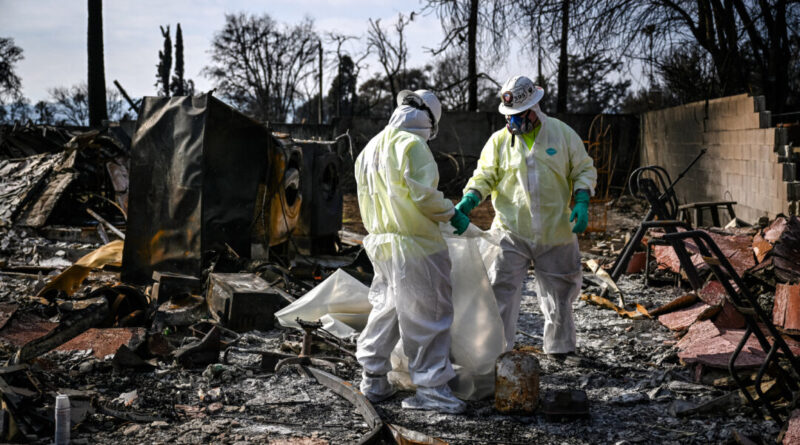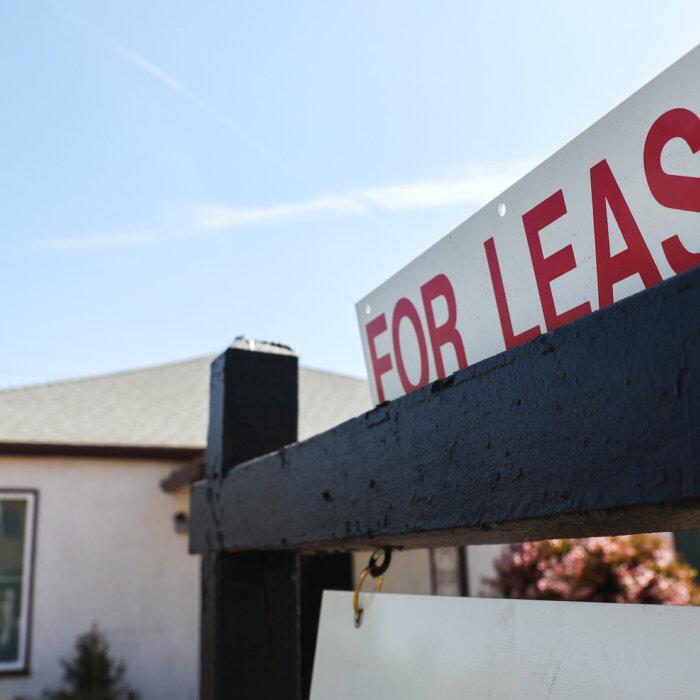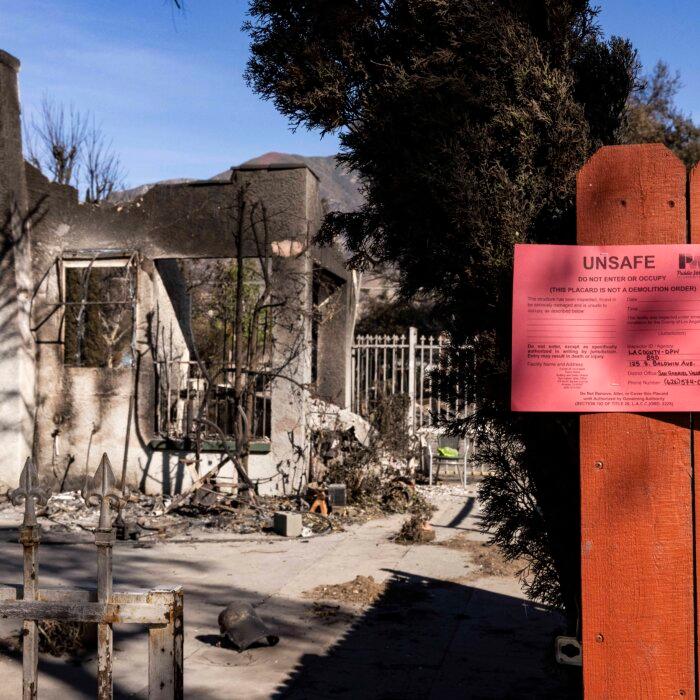‘The Aftermath of Catastrophe’: Toxic Hazards Endanger LA Residents
LOS ANGELES—Anita Ghazarian and Simon Penny reside at the western edge of Altadena—spared from the destructive Eaton Fire flames, yet still engulfed in ash. They also own a rental property further east, which sustained only minor damage.
According to Ghazarian’s insurance adjuster, the rental property will be considered livable once the electricity is restored.
“How can I ask my tenants to move back into a house where the backyard is covered in ash and debris, surrounded by charred neighborhoods? Is it safe for children to play there?” Ghazarian expressed her concerns.
Among the online mapping resources, residents find themselves navigating a confusing landscape: their homes might be categorized in an EPA “normal” zone, indicating it has been recently repopulated post-evacuation, which concurrently registers as green on the county map (indicating minimal or no damage), yet it remains encircled by devastated structures covered in ash.
In the aftermath of Colorado’s Marshall Fire, a significant number of respondents in a survey reported smoke-related symptoms six months post-fire, with a continued prevalence of these symptoms even after thorough remediation.
Residences untouched by the flames exhibited elevated levels of volatile organic compounds (VOCs), including benzene and toluene, brought in by ash and smoke from adjacent burnt properties.
In terms of magnitude, the disaster in Los Angeles significantly surpasses the tragic Marshall Fire, posing a similar environmental threat.
The two major fires in Los Angeles County, located in the Pacific Palisades and Altadena, scorched an area of 40,000 acres—approximately 60 square miles—resulting in 25 fatalities, and the destruction of over 16,000 structures, obliterating entire neighborhoods.


(Top) Smoke and flames engulf a commercial area during the Eaton fire in the Altadena region of Los Angeles County, Calif., on Jan. 8, 2025. (Bottom) Emergency responders tackle houses wrecked while a helicopter releases water on the Palisades Fire in Pacific Palisades, Calif., on Jan. 7, 2025.Josh Edelson, David Swanson/AFP via Getty Images
In total, five simultaneous fires charred over 55,000 acres—nearly three times Manhattan’s size.
“We’re in the aftermath of a catastrophe,” stated Jane Williams, executive director of the nonprofit California Communities Against Toxics.
“Similar to what transpired after 9/11, all anyone desires is a return to normalcy, pressuring officials to declare everything safe, leading people back to consuming local water and breathing the air,” she shared with The Epoch Times.
Even after nearly three weeks, some residents still have not been permitted to assess the ruins of their homes, salvage personal items, or fully confront the disaster.
This conflict—between the urgency to rebuild and the unidentified dangers remaining from the fires—will influence the largest disaster recovery operation in California’s history.
Williams, who has advised governments and communities after some of the most significant recent disasters, including the 2023 Maui fires in Hawaii, predicts that even in environmentally conscious California, advocating for caution will be challenging.
“You’ll see workers in scuba gear and protective suits removing hazardous waste while kids play in nearby parks,” she remarked.
Federal agencies overseeing cleanup efforts have established heightened safety protocols for hazardous waste and debris management, but critical gaps remain.
Particularly, uncertainties linger regarding the safety of buildings that survived the fires and the condition of air, soil, and water in affected areas.
This concern is expected to be highlighted in areas impacted by the Eaton Fire, where devastated homes are surrounded by numerous intact but ash-and-smoke-saturated properties.
Risk tolerance varies among residents; some never evacuated their homes, while others are eager to return. However, the absence of clear guidelines or standards within the federally led cleanup has left many residents unsettled.
As displaced individuals confront the challenges ahead, many are questioning who ultimately bears responsibility for their health and safety—and why the onus for proof seems to rest on them.
Ghazarian is also left contemplating if she will have to handle the removal of the ash-laden soil herself.


Anita Ghazarian and Simon Penny are temporarily living with friends in Glassell Park, Los Angeles, on Feb. 1, 2025.Beige Luciano-Adams/The Epoch Times
The Army Corps of Engineers is in the second phase of a two-step federal cleanup strategy, involving the removal of six inches of soil from affected and destroyed properties. This process could extend for up to a year or more, and clarity on whether it will apply to intact structures like Ghazarian’s rental property remains absent. Currently, the first phase mandates hazardous material removal by the EPA.
During a recent town hall regarding the Eaton Fire recovery, the county’s Department of Public Works (DPW) indicated there were no intentions to conduct soil testing. The EPA stated that air, soil, and water testing falls under local agency responsibility.
Ghazarian noted that insurance companies do not seem eager to invest heavily in such efforts. “They argue it’s not their responsibility.”
Penny, who is accustomed to wildfires from his upbringing in Australia, expressed surprise at the lack of a systematic approach for authorities to establish a baseline for ash testing before rains were forecasted.
“There’s no entity—county, state, or federal—accountable for evaluating toxic ash fallout from fires. Responsibility seems to shift from the Army Corps of Engineers to L.A. County DPW, which in turn points to [L.A. County Board of Supervisors Chair Kathryn] Barger, and Barger defers to the EPA. It’s like a regulatory blame game,” Penny lamented.
Conversations with an industrial hygienist regarding work on their home led to the hygienist stating, “It’s like the wild west out here.”
Requests for comment from the Los Angeles County Department of Public Health and its Department of Public Works went unanswered.
In this absence of information, neighbors searching for clarity have turned to social media for organization. They employ Facebook groups, group emails, Zoom meetings, and texting threads to share heavy metal testing results from private services and strategize data mapping.
They provide one another with advice—for instance, if the insurance company denies soil testing, residents are encouraged to visit FEMA in person to make their case.
In a Reddit forum discussing the situation, an Altadena resident shared findings from an inspector who tested home dust for lead and asbestos. The tests indicated lead levels were up to 33 times the federally and state-regulated thresholds—in areas devoid of visible dust, even in a house outside the burn zone.
“While I understand that I can clean the interior, what terrifies me is that this contamination potentially permeates our streets, our soil, and our yards,” the resident expressed.


(Top) Workers for the EPA remove hazardous materials while searching homes damaged by the Eaton Fire in Altadena, Calif., on Jan. 30, 2025. (Bottom) Pink spray paint marks potential asbestos sources as EPA contractors remove hazardous waste from homes affected by the Eaton Fire in Altadena, Calif., on Jan. 30, 2025.Patrick T. Fallon/AFP via Getty Images
Residents of Altadena are justifiably concerned about asbestos, often cited as a major contributor to post-9/11 health crises.
“This is the most extensive cleanup operation in California’s history,” Williams stated.
The previous largest operation, stemming from decades of contamination by the former lead-battery manufacturer Exide in Los Angeles, was significantly smaller and included third-party oversight, rigorous air monitoring, and comprehensive protocols for worker and community safety, according to Williams.
“All those protective measures we already have might get ignored here, and we’re talking about 50 square miles filled with ash, debris, and toxic waste that needs to be cleared,” she concluded.
Even at Ghazarian’s residence outside the burn area, heavy ash remains present.
“Is it safe to garden? Can we eat food grown there? Can kids safely play in that yard?” Ghazarian queries. “What will the long-term effects be on individuals living in that home in three, five, ten, or twenty years?”
Finding companies capable of conducting thorough testing for various potential contaminants is proving challenging for her.
“We’re essentially on our own, unsure when we can return. Is it safe? What about our tenants? And who is responsible for overseeing all this?”
“Our goal isn’t to prevent people from returning home. We’re asking for official guidelines that clarify for homeowners and insurers what constitutes safety and when it applies,” the petition states.
“Ultimately, the decision should lie with homeowners on whether they wish to return early, but we don’t wish to see them pressured to do so before it is safe.”



(Top) Anita Ghazarian and Simon Penny stay with friends in Glassell Park, Los Angeles, on Feb. 1, 2025. (Bottom) During evacuation, Ghazarian took her mother’s cookbook (Left), handwritten in Farsi, while Penny saved his mother’s diary (Right).Beige Luciano-Adams/The Epoch Times
Known Hazards, New Territory
Almost a quarter-century post-9/11, the number of fatalities due to exposure to contaminants released during the Twin Towers’ collapse has surpassed the number from the attacks themselves—affecting health outcomes related to respiratory, cardiac, cognitive, and digestive disorders, alongside cancer diagnoses.
Drawing parallels between California’s wildfires and 9/11 can provoke backlash. Given the historical context of COVID-19’s response, many are hesitant to incite panic regarding public health.
The immense toxic cloud of dust and ash that enveloped lower Manhattan in 2001 does not precisely mirror California’s fires—but it, along with other contemporary disasters, illustrates the relocation and persistence of toxic contaminants posing long-term threats to public health.
Not only is the size of the fires significant, but also the materials they incinerated.
Spanning urban and wild landscapes, the wind-driven fires obliterated electric vehicles, solar panels, gas tanks, lithium-ion batteries, plastics, and asbestos, releasing a dangerous mix of hazardous toxins into the environment.
Pollutants released by such fires and concentrated in ash present known dangers, correlating with immediate irritations and chronic diseases, as well as increased cancer risks. Even brief encounters with asbestos and hazardous metals like lead and arsenic can result in significant health issues years after exposure, warned officials in L.A. County.
Other chemicals identified in urban wildfires—sometimes at quantities far exceeding those typical in wildfires—include polycyclic aromatic hydrocarbons, dioxins and furans, in addition to toxic VOCs like benzene, all described as carcinogens, absorbed via inhalation, ingestion, or skin contact.


(Top) Molten metal flows from a vehicle torched during the Palisades Fire in Pacific Palisades, Calif., on Jan. 10, 2025. (Bottom) Houses marked “unsafe” sit amidst damage from the Eaton Fire in Altadena, Calif., on Jan. 24, 2025.Valerie Macon/AFP via Getty Images, John Fredricks/The Epoch Times
The imperceptible, ultrafine particles released during the fires could affect almost every organ in the body, including the brain, which may lead to various effects on metabolism, cognition, and memory, as explained by Ed Avol, a clinical medicine professor with the University of Southern California, during a health-impact webinar organized by the California Coalition for Clean Air.
“These particles are small enough to bypass the body’s defense mechanisms and enter the bloodstream, where they can circulate and impact almost every organ system,” Avol noted.
But the public remains largely uninformed.
Current air quality sensors fail to detect these finer particles, which are smaller than those tracked by government agencies through the Air Quality Index, according to Avol.
‘No Definitive Answer’
As the smoke abates, experts frequently express that there’s no definitive measure residents of Los Angeles County can rely on to determine safety; it largely hinges on wind patterns.
Williams reminisced about researchers who analyzed the Camp Fire that devastated Paradise, California, finding lead particles as far away as 150 miles. “This is why health consequences from the Twin Towers affected such a wide area,” she explained.
The pressing issue for California now, she asserts, is the absence of a government entity reliably monitoring the most hazardous toxins released during the fires.


(Top) Smoke from wildfires obscures the skyline of downtown Los Angeles, severely impacting air quality in the area, on Jan. 9, 2025. (Bottom) Visitors at sites damaged by the Eaton Fire in Altadena, Calif., don face masks on Jan. 8, 2025.Mario Tama/Getty Images
“You won’t see any monitoring aimed at air toxics. It’s strictly regional pollutants included in the Air Quality Index. There are well-meaning people asserting that if the AQI is satisfactory, everything is fine. However, if you’re within a few miles of ash zones, even with a perfect AQI, potentially hazardous materials like asbestos and metals could still persist in the air,” Williams cautioned.
In a communication to The Epoch Times, the South Coast Air Quality Management District noted it routinely measures lead, arsenic, and other toxic metals across multiple locations throughout the L.A. County Basin.
Data analyzed after Jan. 7, when both the Eaton and Palisades fires ignited, indicated elevated levels of toxic metals, surpassing those from other regional fires, but claimed that these levels had “decreased significantly” since Jan. 12, returning to pre-fire measurements.
The air quality district acknowledged the complexity of determining the extent of fallout from smoke and ash, contingent on variables like wind speed and direction, but noted that ash from initial smoke plumes has likely settled and that rain may have aided in preventing it from becoming airborne again.
Nonetheless, remaining ash can dry and become airborne again, especially in windy conditions.
“There is no clear timeline for how long this issue might last,” the district stated. “In cases involving wildland fires, we’ve observed ash being transported on windy days until vegetation recovers in spring. Yet, these fires impacted a densely populated area, so urban ash dynamics could differ significantly.”
On Jan. 31, over three weeks after the outbreak of fires, the district announced it had commenced additional monitoring in the burn scars from both the Palisades
Source link






